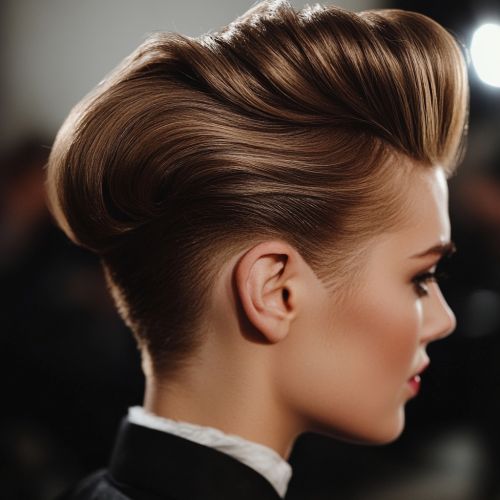Pompadour
Introduction
The term "Pompadour" refers to a hairstyle named after Madame de Pompadour, the mistress of King Louis XV of France. This elaborate style has evolved significantly since its inception in the 18th century, influencing various cultural and fashion trends. The pompadour is characterized by hair swept upwards and back from the forehead, creating a voluminous and elevated look. This article delves into the historical origins, variations, cultural significance, and technical aspects of the pompadour hairstyle.
Historical Origins
The pompadour hairstyle originated in the 18th century and is named after Jeanne-Antoinette Poisson, better known as Madame de Pompadour. As the chief mistress of King Louis XV, she became a prominent figure in French court life and fashion. The hairstyle she popularized involved a high, rounded mass of hair arranged above the forehead, often adorned with ribbons, flowers, or feathers.
18th Century France
During the reign of Louis XV, the pompadour became a symbol of aristocratic elegance and sophistication. It was not only worn by women but also by men, who adapted the style to suit their own tastes. Men's pompadours were often less elaborate but still featured the characteristic height and volume.
Evolution in the 19th and 20th Centuries
As fashion trends shifted, the pompadour underwent various transformations. In the 19th century, the style became more subdued, aligning with the Victorian era's emphasis on modesty. However, the early 20th century saw a resurgence of the pompadour, particularly in the 1940s and 1950s, when it became associated with rock and roll culture.
Technical Aspects
Creating a pompadour involves several technical steps, including sectioning, backcombing, and styling. The process requires skill and precision to achieve the desired height and volume.
Hair Preparation
To create a pompadour, the hair must be clean and dry. Stylists often use volumizing products, such as mousse or root-lifting sprays, to add texture and body. The hair is then sectioned into parts, with the front section reserved for the pompadour itself.
Backcombing and Teasing
Backcombing, also known as teasing, is a crucial step in creating a pompadour. This technique involves combing the hair towards the scalp to create a cushion of volume. The backcombed sections are then smoothed over to achieve a polished look.
Styling and Finishing
Once the hair is backcombed, it is styled into the characteristic pompadour shape. This involves sweeping the hair upwards and back from the forehead, securing it with pins or clips as needed. A strong-hold hairspray is often used to keep the style in place.


Variations
The pompadour has numerous variations, each with its own unique characteristics. These variations cater to different hair types, lengths, and personal preferences.
Classic Pompadour
The classic pompadour features a high, rounded front section with the sides and back neatly combed. This style is often associated with the 1950s rock and roll era and remains popular among enthusiasts of vintage fashion.
Modern Pompadour
The modern pompadour incorporates contemporary elements, such as undercuts or fades. This variation offers a more edgy and versatile look, suitable for both casual and formal settings.
Women's Pompadour
While traditionally associated with men, the pompadour has also been adapted for women. Women's pompadours often feature softer, more feminine lines and can be paired with various updos or loose hairstyles.
Cultural Significance
The pompadour has played a significant role in various cultural movements and continues to be a symbol of style and individuality.
Rock and Roll Era
In the 1950s, the pompadour became synonymous with rock and roll culture. Icons like Elvis Presley and James Dean popularized the style, making it a symbol of rebellion and youthful exuberance.
Subcultures
The pompadour has been embraced by various subcultures, including the Rockabilly and Psychobilly scenes. These groups have kept the style alive, adding their own unique twists and interpretations.
Fashion and Media
The pompadour frequently appears in fashion editorials, films, and television shows. Its enduring appeal lies in its versatility and ability to convey a sense of confidence and flair.
Technical Challenges
Creating and maintaining a pompadour can present several challenges, particularly for those with fine or naturally straight hair.
Hair Type Considerations
Different hair types require different techniques and products to achieve a successful pompadour. For example, individuals with curly hair may need to straighten their hair before styling, while those with fine hair might require additional volumizing products.
Maintenance
Maintaining a pompadour requires regular upkeep, including frequent trims and the use of styling products. Humidity and weather conditions can also affect the longevity of the style, necessitating touch-ups throughout the day.
Conclusion
The pompadour is a timeless hairstyle that has evolved significantly since its inception in the 18th century. Its enduring popularity can be attributed to its versatility, cultural significance, and the skill required to create it. Whether worn in its classic form or adapted to modern trends, the pompadour remains a symbol of style and individuality.
